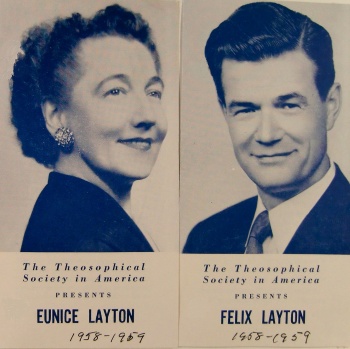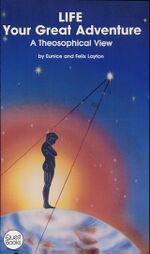Felix Layton
ARTICLE UNDER CONSTRUCTION
ARTICLE UNDER CONSTRUCTION
Felix Layton was a lecturer and educator who was active in the Theosophical Society in America. He often toured with his wife Eunice.
Personal life
Felix Layton was born on September 10, 1910 in Paignton, Devon, England, and raised in a family of Theosophists.[1] His parents were Wilfred Layton, an organist and music teacher, and his wife Ethel. The couple had two daughters before their son was born.[2] Felix attended St. Christopher’s School, a Theosophical institution, where he first became acquainted with his mentor, Geoffrey Hodson.[3] In the 1920s, Felix and his mother emigrated to Canada, and from there went to Michigan, where he earned a Bachelor of Science degree at the University of Michigan.[4]
During World War II he served in the Royal Corps of Signals, and then the Royal Air Force Volunteer Reserve, ending with the rank of major.[5][6][7] He then returned to the U.S. in 1947 and taught science in high schools in San Francisco area for several years. Layton was married to Eunice Shipp on October 21, 1950 at Alameda.[8] They had probably met at the Pacific Lodge of the Theosophical Society, where both were members in the later 1940s.[9] On March 17, 1952, he became a naturalized citizen of the United States.[10]
Theosophical Society work
Felix Layton was admitted as a member of the Theosophical Society in America on September 15, 1930, joining the Flint, Michigan lodge. Previously he and his mother Ethel Laytons had been member since about 1928 in the Canadian Section.[11][12] He was president of Young Theosophists of America from 1933-1934.
"Responding to a request from International President George Arundale for workers, as a young man he sailed for India. He spent seven years in Adyar teaching and later as headmaster of the Besant School."[13] Radha Burnier was one of his students. On April 23, 1936 he transferred his membership to India. He lived at the Adyar headquarters for several years, serving as a teacher and house master at Besant Memorial School. He was Joint General Secretary of the World Federation of Young Theosophists from 1936-1937. After completing his wartime service in the British Army, he returned to the United States, and on November 13, 1947 transferred his TS membership back to the American Section.[14][15] He took a position and teacher and house head at the Montezuma Boys School in Santa Clara.[16] Around that time, he and Eunice Shipp were both members of the Pacific Lodge in San Francisco, and they got married. Felix was elected president of the Northern California Theosophical Federation.[17]
The Laytons served for for several years on the staff of the National Headquarters in the Department of Information. From 1954 to 1959, they travelled throughout the United States, lecturing and conducting classes on Theosophy in a rigorous schedule. During their Spotlight tour of Florida in the first three months of 1957, for example, they visited eight cities, giving 35 lectures and attending 9 meetings. In 1959, the Laytons began a world tour that took them to the International headquarters of the Society where they attended the School of the Wisdom, later serving as Assistant Directors of Study at that School.[18] Felix Layton was elected as vice president of the Theosophical Society in America in 1966, serving until 1972 in the administration of Joy Mills. Their lecture schedule took them to New Zealand, Australia, Indonesia, Malaya and Ceylon, India, and Pakistan, plus a six-month lecture tour in Europe. They were very much in demand as lecturers.
In 1972 the couple took a break from their travels, returning to San Francisco, with a big farewell party from the staff of the Wheaton, Illinois headquarters, and a big welcome-home party in California. In 1977, they moved to Krotona Institute of Theosophy in Ojai, California, and it became their base in Theosophical work. They were co-directors of the Krotona School of Theosophy from 1977-1979. From 1986 until his death in 1991, Felix was vice-president and resident head of the Institute, and Eunice supported him in this work.
Liberal Catholic Church
Felix Layton was active in the Liberal Catholic Church, but no more information is available.
Freemasonry
Later years
Laytons retired from lecturing to live in San Francisco. Over 50 members of California lodges united to hold a welcome party at the home of Mr. and Mrs. George Barthholemew.[19]
On September 21, 1991, Felix Layton passed away in Ojai, California, after a brief illness.
According to an article written in 1991,
Felix was born September 10, 1910 and raised in a theosophical family in England. Responding to a request from International President George Arundale for workers, as a young man he sailed for India. He spent seven years in Adyar teaching (Radha Burnier was one of his students) and later as headmaster of the Besant School.
He then returned to the U.S. and taught science in high schools in the San Francisco area for several years. He soon found himself working full time for the Society again, and for the next 20 years, he and his wife, Eunice, traveled and lectured throughout the U.S. and around the world. As part of the American Section’s regional expansion program, they spoke to both public and theosophical audiences. During this time they returned to Adyar to direct the School of the Wisdom. Felix served as national vice-president of the American Section from 1966 to 1972. The Laytons came to Krotona in 1977 and were co-directors of the Krotona School for three years. In 1986 he was appointed resident head of the Krotona Institute by Radha Burnier.
The Laytons’ public talks have been compiled in the Quest book, Life, Your Great Adventure.
Felix was a 32nd degree Co-Mason, American Federation of Human Rights, and was also a priest in the Liberal Catholic Church. He is perhaps best remembered by those who knew him for his kind and gentle nature. He was deeply committed to the animal welfare movement, and had a special interest in healing. He had a fondness for the book Light on the Path, and inspired many with his dedication to making Theosophy real in his life.
A requiem mass was held at the Church of Our Lady and All Angels in Ojai on September 24.[20]
Theosophy in Australia reported,
Much of his energies were given in the area of teaching, first as a teacher in Adyar where he spent some time and, later, in the United States where he and his wife, Eunice, are especially remembered for the arduous spotlighting tours they undertook, organising one-night stands in different cities where there was no theosophical lodge or group.
They were well-known to Australian audiences, having toured the Section on several occasions as guest speakers. At Convention, when the talks and workshops were over for the day, members relaxed and enjoyed the Square and Scottish Dancing, Eunice led so efficiently in the evening. [21]
Writings
- Some Basic Concepts of Theosophy. Adyar, Madras, India: Theosophical Publishing House, 1960. Coauthor Eunice Layton, with foreword by Geoffrey Hodson. Based on a series of lectures. Available at hpb.narod.ru. Translated into Dutch.
- Theosophy: Key to Understanding. Wheaton, Ill: Theosophical Publishing House, 1967. 170 pages. Coauthor Eunice Layton. Reissued in 1988 as Life, Your Great Adventure: a Theosophical View. Translated into Finnish and Italian. Available for borrowing online at Internet Archive.
- Einstein's Theories: In the Light of Theosophy. Wheaton, Illinois : Theosophical Press, 1955. 21 pages. Pamphlet.
Additional resources
Audio
- Light on the Path. Wheaton, Illinois: The Theosophical Society in America, 1970. "Felix Layton explains that the aphorisms or rules contained in the cryptic and paradoxical book Light on the Path date back to ancient Alexandria and Egypt. Layton also gives practical suggestions for studying the work."
- Light on the Path. 1970. "The book discussed as a guidebook for use during the student's entire life."
- The Second Object of the Theosophical Society. Wheaton, Illinois: The Theosophical Society in America, 1970. 85 minutes.
Notes
- ↑ Felix Layton in 1910 England & Wales, Civil Registration Birth Index, 1837-1915.
- ↑ 1911 Census of England and Wales.
- ↑ Footnote to Felix Layton's article "In Memoriam: Geoffrey Hodson, 1886-1983" The American Theosophist 71 no.3 (March, 1983): 69.
- ↑ "Layton, Felix" The International Theosophical Year Book 1938(Adyar, Madras, India: Theosophical Publishing House, 1938), 194.
- ↑ 1941 UK, London Gazettes World War II Military Notices, 1939-1945.
- ↑ 1944 UK, London Gazettes World War II Military Notices, 1939-1945.
- ↑ Ledger Sheets 4. Membership records. Theosophical Society in America Archives.
- ↑ 1950 California, U.S., Marriage Index, 1949-1959.
- ↑ Ledger Sheets 4. Membership records. Theosophical Society in America Archives.
- ↑ 1952 U.S., Naturalization Record Indexes, 1791-1992.
- ↑ Felix Layton membership record. Ledger Cards microfilm reel 5. Theosophical Society in America Archives.
- ↑ "Layton, Felix" The International Theosophical year Book 1938 (Adyar, Madras, India: Theosophical Publishing House, 1938), 194.
- ↑ "Felix Layton, 1910-1991" The American Theosophist 79 no.6 (November, 1991): 3-4.
- ↑ Felix Layton membership record. Ledger Sheets microfilm reel 4. Theosophical Society in America Archives.
- ↑ "Layton, Felix" The International Theosophical year Book 1938 (Adyar, Madras, India: Theosophical Publishing House, 1938), 194.
- ↑ 1950 United States Federal Census.
- ↑ "Northern California Federation" The American Theosophist 41 no.11 (November, 1953): 224-225.
- ↑ Anonymous, "The Theosophical Society Presents Eunice Layton" publicity flyer. Leenhouts Papers. Theosophical Society in America Archives.
- ↑ "New and Notes: Welcome to the Laytons," The American Theosophist 60.10 (October, 1972), 273.
- ↑ "Felix Layton, 1910-1991," The American Theosophist 79.6 (November-December 1991), 3-4.
- ↑ "Felix Layton," Theosophy in Australia 55.4 (December 1991), 94.

